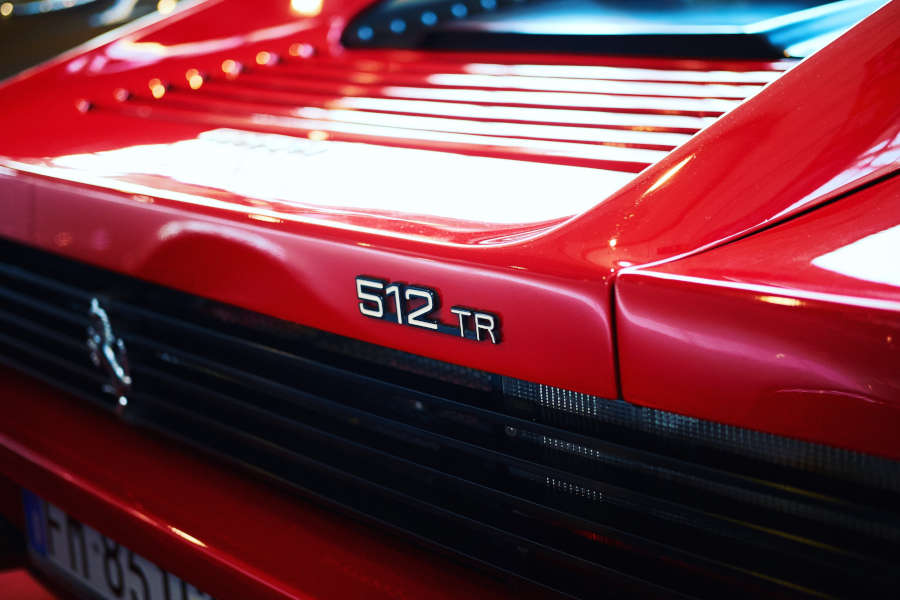
In our “Trademarks” newsletters of 25 June and 24 September 2020, we reminded you that any holder of a trademark has the obligation to effectively use it in the 5 years following its registration and, beyond that time, to never suspend such effective exploitation without serious grounds for an uninterrupted period of 5 years.
How does this rule stand when the owner uses the trademark to sell second-hand goods of the trademark he already markets?
This question was raised at the European Court in two cases between Ferrari SpA and DU, the latter having filed a claim for the cancellation of Ferrari SpA’s trademark rights in respect of two of its trademarks, in this particular case  (1).
(1).
Brief reminder of the facts:
Presented at the Paris Motor Show in 1984, the Ferrari “Testarossa” car met with great success and appeared in the famous series Miami Vice. On sale until 1991, it was then replaced by the 512 TR model (TR for Testarossa) which was sold until 1996 and of which a total of 7,177 vehicles were produced.
Within this framework, Ferrari SpA registered the distinguishing sign  in Switzerland and Germany on 22 July 1987 and 7 May 1990, respectively, as a Class 12 trademark, i.e. pertaining to Land vehicles (…) and parts thereof.
in Switzerland and Germany on 22 July 1987 and 7 May 1990, respectively, as a Class 12 trademark, i.e. pertaining to Land vehicles (…) and parts thereof.
A claim for the cancellation of Ferrari SpA’s trademark rights on its  trademarks for lack of effective use for an uninterrupted period of 5 years was brought by DU.
trademarks for lack of effective use for an uninterrupted period of 5 years was brought by DU.
In its defence,
Ferrari SpA maintained that it used its brand between 2011 and 2016 (the relevant period to demonstrate the use of the trademarks whose rights were under attack), i.e. after the “Testarossa” had ceased being sold in 1991,
– by selling, after inspection, second-hand vehicles bearing the disputed trademarks,
– by supplying spare parts and accessories for vehicles bearing the disputed trademarks (generating revenues of approximately 17,000 Euros for almost 7,000 vehicles bearing the disputed trademarks),
– by proposing maintenance services for these cars.
Whilst the court of first instance expressed the view that the sale of used  vehicles did not constitute effective exploitation of the disputed trademarks, The Higher Regional Court, Dusseldorf, Germany, doubtful of this interpretation, made requests for a preliminary ruling to the European Court of Justice (ECJ), made by decisions of 8 November 2018.
vehicles did not constitute effective exploitation of the disputed trademarks, The Higher Regional Court, Dusseldorf, Germany, doubtful of this interpretation, made requests for a preliminary ruling to the European Court of Justice (ECJ), made by decisions of 8 November 2018.
The ECJ judgement of 20 October 2020 provides an interpretation that is extremely interesting for trademark holders in respect of these questions of use.
Following are certain aspects of this decision that constitute new elements.
We remind you that a trademark is considered as “effectively exploited” when it is exploited in accordance with its essential function, which is to guarantee the identity of the origin of the products or services for which it was registered, in order to create or preserve a market for such products and services.
This excludes the token use for the sole purpose of maintaining rights conferred by the trademark.
The appreciation of the effective nature of the exploitation of the trademark must be based on all the facts and circumstances required to establish the reality of its commercial exploitation, in particular:
– exploitation considered as justified in the concerned economic sector to preserve or create market share for the products or services protected by the trademark,
– the nature of these products or services,
– market characteristics,
– the scope and frequency of trademark exploitation.
1/ Is a trademark considered to be the object of effective exploitation by its owner, when the latter sells used goods marketed under that trademark?
The sale itself of used goods bearing a trademark does not mean that the trademark is “exploited”.
Effectively, the trademark in question was exploited when it was put, by its owner, on the new goods, when such goods were first put on the market.
This nuance stems from the principle of the exhaustion of trademark rights.
According to this principle, the right conferred by the trademark does not allow its owner to prohibit its use for products already put on the market in the European Union, under that trademark, by the trademark owner, or with his consent.
An erroneous interpretation of this article could lead to the conclusion that the exploitation of a trademark for products that were already put on the market by the trademark owner or with his consent would not constitute use as a trademark.
The Court ruled on this essential point.
Whereas it recognises that the trademark owner no longer controls the marketing of his products by third parties when such products have been put on the market with his agreement, it considers, however, that if the trademark owner effectively exploits his trademark within the framework of the commercialisation of used goods bearing the trademark concerned, such use may constitute “effective exploitation” of the trademark concerned.
Therefore, it recognises that a trademark is considered to be the object of effective use by its owner when the latter sells used goods put on the market under that trademark.
2/ Is a trademark considered as effectively exploited by its owner when the latter provides certain services relative to products previously sold under that trademark?
The Court responds positively: exploitation is considered effective when the services are directly related to the products previously sold and aim to satisfy the needs of customers having purchased those products.
It specifies: Such exploitation presupposes that such services are supplied by the trademark owner.
3/ The specificity of the appreciation of the use of a trademark designating luxury goods, in practice
Luxury goods are often sold in small numbers and during a short period of time. This strategy makes them rare and objects of desire for collectors.
It also makes them vulnerable to cancellation of trademark rights due to lack of effective exploitation. Effectively, where it is established by case law that, for luxury products, the sale of a relatively small number of products constitutes effective exploitation, such sales must effectively take place.
This decision by the ECJ raises hope for the survival of luxury trademarks whose owners may have totally ceased selling new products but who continue, nevertheless, to use their trademarks for the sale of used products of the same brand or to provide directly related services.
(1) EC, 22/10/2020, C-720/18 et C-721/18, Ferrari, ECLI: EU:C:2020:854.





